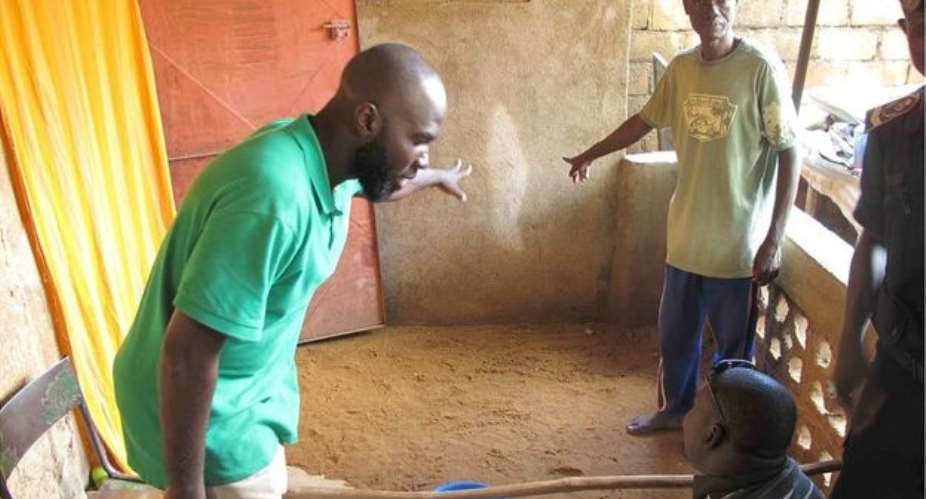Thousands of Malians have reportedly been trooping to see this 'white image on the outside wall of a toilet - yes, a toilet of all places - said to be a religious sign. It shows 'a man praying' and indeed Malians believe the sign is a message from God, the Islamic God.
Mail is predominantly a muslim country and most muslims in Southern Mali belong to the moderate Sufi Tijani sect that 'respects miracle signs'. The sign has been generating many claims and ideas among Malians. A Malian calls it a 'vision' from prophet Muhammad but he did not indicate how he knew it was a sign from prophet Muhammad and not any other prophet or person living or dead. He claims that the religious sign has been changing shape without detailing the shapes it took. He maintains that the sign leaves the wall, moves around the compound and then goes back to its original place, in obvious defiance of the laws of gravity.
A school teacher describes it as a 'true sign from God' but did not state why God sent the sign to muslims in Bamako not in Gao or in Sikasso. A BBC reporter says the religious sign is a 'drying patch of cement in the shape of a standing woman'. A standing woman?
Now the issue is : Why do Malians describe a 'parch of cement' as a religious sign? If Tijani muslims believe in miracle signs, does it mean that they should take any sign to be a religious sign- including a sign on a toilet wall? What makes a sign religious? What makes a particular sign an islamic, not christian, religious sign? How does one differentiate a religious from a non religious sign? And who determines what is a religious sign in the first place? Did the sign float in the air as claimed, and at what time of the day or night? What is the mental state of the person who claimed to have seen this patch of cement floating around?
Meanwhile some years ago, people flocked to a local restaurant in Kebbi in Northern Nigeria to see pieces of meat which the owner of the restaurant said had inscriptions of Allah and prophet Muhammad. While a muslim housewife in the UK chopped a tomato in half, and found that “bismillah, or Allah, was written in Arabic in the veins. The other half of the vegetable said la illaha illala, or There is no God but Allah”
The main question is : Why are Islamic religious signs appearing only to muslims or in muslim dominated countries or communities? Why can't islamic religious signs appear to christians in Liberia or to Sango worshippers in Southern Nigeria? Why can't Allah manifest itself clearly without hiding behind patches of cement or chopped tomatoes? Can't Allah or prophet Muhammad - if they exist - send incontrovertible signals to muslims whether they believe in miracle signs or not? There is no evidence that these religious signs - whether in Mali or in Nigeria - have anything to do with Allah or prophet Muhammad. In fact there is no evidence that Allah exists or an active prophet Muhammad exists and operates as believed today. These so called religious signs are projections of muslims and typical cases of what Stewart Guthrie described as 'Faces in the Clouds'.
Obviously the conflict in Mali has worsened living conditions in the country deepening situations of poverty and misery. Many people across Mali are in dire situation and are desperately looking out for signs of Allah's presence or at least some covert intervention. Under such circumstances, patches of paint or cement can easily translate into 'true signs' of Allah's manifestation and protection.
I mean, Skeptics in Mali, where are you?





 April 20: Cedi sells at GHS13.63 to $1, GHS13.06 on BoG interbank
April 20: Cedi sells at GHS13.63 to $1, GHS13.06 on BoG interbank
 Dumsor: I'm very disappointed in you for messing up the energy sector — Kofi Asa...
Dumsor: I'm very disappointed in you for messing up the energy sector — Kofi Asa...
 Dumsor: Instruct ECG MD to issue timetable and fire him for lying — Kofi Asare t...
Dumsor: Instruct ECG MD to issue timetable and fire him for lying — Kofi Asare t...
 Ashanti region: Road Minister cuts sod for 24km Pakyi No.2 to Antoakrom road con...
Ashanti region: Road Minister cuts sod for 24km Pakyi No.2 to Antoakrom road con...
 Train crash: ‘How could any normal person leave a car on rail tracks?’ — Frankli...
Train crash: ‘How could any normal person leave a car on rail tracks?’ — Frankli...
 Train crash: Driver of abandoned vehicle not our branch chairman nor secretary —...
Train crash: Driver of abandoned vehicle not our branch chairman nor secretary —...
 Kenya pays military homage to army chief killed in copter crash
Kenya pays military homage to army chief killed in copter crash
 US agrees to pull troops from key drone host Niger: officials
US agrees to pull troops from key drone host Niger: officials
 Mahama vows to scrap teacher licensure exams, review Free SHS policy
Mahama vows to scrap teacher licensure exams, review Free SHS policy
 Government will replace burnt Madina shops with a new three-story, 120-store fac...
Government will replace burnt Madina shops with a new three-story, 120-store fac...
